Engine - removal leaving manual gearbox in vehicle
Warning: Vehicles equipped
with air conditioning:
Components of the air
conditioning system may
obstruct work being undertaken
on the engine and it is not always possible
to unbolt and move them aside
sufficiently, within the limits of their
flexible connecting pipes. In such a case,
the system should be discharged by a
Ford dealer or air conditioning specialist.
The refrigerant is harmless under normal conditions but in the presence of a naked flame (or a lighted cigarette) it forms a highly toxic gas. Liquid refrigerant spilled on the skin will cause frostbite. If refrigerant enters the eyes, rinse them with a diluted solution of boric acid and seek medical advice immediately.
Note: A hoist and lifting tackle will be required.
1 Disconnect the battery negative lead.
2 Remove the bonnet.
3 On carburettor models, remove the air cleaner.
4 On fuel injection models, remove the air inlet hose, plenum chamber, and air cleaner lid as an assembly.
5 Disconnect the breather hose from the camshaft cover, and unscrew the bolt securing the hose support bracket to the left-hand side of the cylinder head (see illustration).
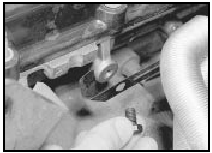
5.5 Removing the hose support bracket bolt from the cylinder head
6 Drain the cooling system.
7 To provide additional working space, remove the radiator.
8 Disconnect the coolant hoses from the coolant pump housing on the left-hand side of the engine.
9 Disconnect the coolant hoses from the thermostat housing.
10 Disconnect the heater coolant hose from the inlet manifold.
11 Where applicable, release the coolant hose from the bracket under the carburettor automatic choke housing.
12 On carburettor models, disconnect the vacuum pipe from the engine management module.
13 Disconnect the brake servo vacuum hose from the inlet manifold.
14 On fuel injection models, disconnect the vacuum pipes from the MAP sensor (located at the rear right-hand side of the engine compartment) and, where applicable, from the air conditioning system.
15 On carburettor models, disconnect the fuel supply and return hoses at the carburettor, and plug the ends of the hoses to minimise petrol spillage. Take adequate fire precautions.
16 On fuel injection models, slowly loosen the fuel feed union at the fuel rail, to relieve the pressure in the fuel system before disconnecting the union. Be prepared for petrol spillage, and take adequate fire precautions. Disconnect the fuel feed hose, and disconnect the fuel return hose from the fuel pressure regulator. Plug the ends of the hoses to minimise petrol spillage.
17 Disconnect the throttle cable and move it to one side.
18 Disconnect the HT lead from the ignition coil, and unclip it from the timing chain cover.
19 Disconnect the wiring from the following
components as applicable, depending on
model:
Alternator.
Starter motor.
Oil pressure warning lamp switch.
Temperature gauge sender.
Cooling fan switch.
Anti-dieselling valve (carburettor models).
Automatic choke heater (carburettor models).
Engine coolant temperature sensor.
Crankshaft speed/position sensor.
Air charge temperature sensor.
Throttle position sensor.
Fuel temperature sensor.
Fuel injectors.
20 On models fitted with power steering, unbolt the power steering pump from its mounting bracket and move it clear of the engine. Note that there is no need to disconnect the fluid hoses, but make sure that the pump is adequately supported to avoid straining them.
21 On models fitted with air conditioning, unbolt the air conditioning compressor from its mounting bracket, and move it clear of the engine. Do not disconnect the hoses; make sure that the compressor is adequately supported to avoid straining them.
22 Unscrew and remove the top engine-togearbox bolts which are accessible from the engine compartment. Note the location of the bolts, and note the positions of the earth strap and any wiring clips attached to the bolts (see illustration).
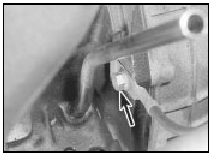
5.22 Earth strap position on top engine-togearbox (arrowed)
23 Unscrew the securing bolt, and disconnect the earth lead from the rear lefthand side of the cylinder head.
24 Unscrew the nuts securing the engine mountings to the engine mounting brackets.
25 Apply the handbrake, jack up the front of the vehicle and support it securely on axle stands (see “Jacking and Vehicle Support”).
26 Drain the engine oil into a suitable container.
27 Remove the starter motor.
28 Remove the exhaust downpipe.
29 Ensure that the steering wheel is positioned in the straight-ahead position, then remove the clamp bolt from the lower steering column clamp, swivel the plate to one side, and disconnect the lower steering column from the lower flexible coupling (see illustration).

5.29 Removing the lower steering column clamp bolt
30 Working inside the vehicle, place a wooden block under the clutch pedal to raise it fully against its stop, so holding the automatic adjuster pawl clear of the toothed quadrant.
31 Disconnect the clutch cable from the clutch release arm, and pass the cable through the bellhousing.
32 Support the gearbox with a trolley jack, using a block of wood between the jack and the gearbox to spread the load.
33 Unscrew and remove the remaining engine-to-gearbox bolts, and remove the bolt from the engine adapter plate (see illustration).
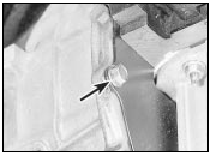
5.33 Engine adapter plate bolt (arrowed)
Recover any shims fitted between the sump and the gearbox when removing the lower engine-to-gearbox bolts.
34 Make a final check to ensure that all relevant wires, pipes and hoses have been disconnected to facilitate engine removal.
35 Attach a suitable hoist to the engine lifting brackets located at the front and rear of the cylinder head, and carefully take the weight of the engine.
36 To improve clearance in the engine compartment when lifting the engine, unbolt the engine mounting brackets from the cylinder block, and remove them (see illustration).

5.36 Remove the engine mounting brackets to improve clearance
37 Detach the brake lines from the front suspension crossmember (see illustration).
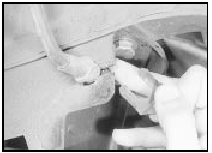
5.37 Removing a brake line securing clip from the suspension crossmember
38 Support the crossmember with a jack (do not remove the jack from under the gearbox), then loosen the bolts securing the crossmember to the underbody. Remove the bolts from one side (see illustration), and carefully lower the crossmember sufficiently to allow the sump to clear the steering rack and crossmember when pulling the engine forwards from the gearbox.
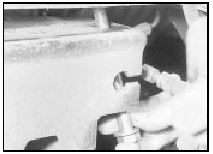
5.38 Removing a suspension crossmember securing bolt
39 Gently raise the engine, then pull it forwards to disconnect it from the gearbox.
Ensure that the gearbox is adequately supported, and take care not to strain the gearbox input shaft. It may be necessary to rock the engine a little to release it from the gearbox.
40 Once clear of the gearbox, lift the engine from the vehicle, taking care not to damage the components in the engine compartment (see illustration).

5.40 Lifting the engine from the vehicle
See also:
Fuel pump - removal and refitting
The fuel pump is integral with the fuel level
sender unit in the fuel tank. Removal and
refitting are as described in Part C of this
Chapter for models with the CFI system. ...
Engine oil and filter renewal (Every 6000 miles or 6 months)
1 Frequent oil and filter changes are the most
important preventative maintenance
procedures that can be undertaken by the DIY
owner. As engine oil ages, it becomes diluted
and contaminated, which ...
Routine maintenance and servicing
Ford Sierra maintenance schedule
The maintenance intervals in this manual
are provided with the assumption that you will
be carrying out the work yourself. These are
the minimum maintenance interv ...
